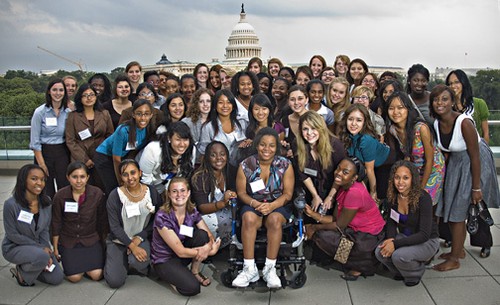Girl Power: The Case for Women in Politics
February 21, 2013
By Laela Zaidi, a 16-year-old sophomore at Joplin High School in Missouri for Huffington Post – President Obama highlighted in his State of the Union address last week the growing need for American high schools to create science, technology and math-driven classes. However, while it is true that these industries have a high demand for jobs, there is another important category of education which tends to be overlooked: Student government programs — particularly ones aimed towards young women — have been forgotten for far too long. Not only would these programs empower young girls with the opportunity to learn about government, but they would also solve the undeniable gender gap in American politics.
The 113th Congress, which intervened this year, included a record-breaking number of women. Despite the reason for celebration, there is hardly much equity in our country’s political processes. Women only make up 18.1 percent of the 535 members of Congress, and as of last year, the United States placed 91st in worldwide rankings of women in national legislature.
At face value, the involvement of women in government may seem like a non-issue. Our secretary of state, Hillary Clinton, has the highest approval rating than any other official in the Obama administration. Former first female speaker of the House, Nancy Pelosi, is still the leader of the Democratic minority. However, the persistent gap in American politics dramatically affects the volume of women’s voices. Issues such as reproductive rights and equal pay played important factors in the political discussions of the recent presidential election, yet studies find that men dominate media coverage rather than women over all these topics. For example, in front page articles concerning abortion or birth control during the 2012 election, men were more four to seven times more likely to be cited than women. Stories discussing women’s rights fare slightly better, as 31 percent of quotes were cited by women, whereas 52 percent from males. While these numbers may be indicative of a lack of women across all specialized fields, like in health care and science, it is clear that the voices of women are still not well-represented and balanced.
One of the main reasons why there is a persistent gender gap in politics is simply because women are not encouraged to participate as often as men are. A study conducted by the Women and Politics Institute found that women are just as likely to respond favorably to a suggestion of a candidacy, but they are less likely to receive it on all local, state, and federal levels of office. The study went on to say that men are 25 percent more likely to believe they possess political traits such as a “thick sin, an entrepreneurial spirit, and a willingness to take risks.” In sum, the study indicates women have less political ambition, not because they are less likely to win against men but because of their negative self-assessments and lack of encouragement.
An easy fix to this problem is pushing young women, starting in middle or high school and beyond, to actively participate in leadership. Unfortunately, there is even a gender gap in student government. Take, for example, the American Legion’s Boys and Girls State. This is a student government program held in almost every state, which gives both female and male students each a week to intensively study government and run in mock elections. For Missouri Boys/Girls State, my high school typically picks seven boys in the upcoming senior class to attend, whereas there is only enough money to take three girls.
Such lack of imbalance persists even further in college. The Washington Post reported at the top 50 colleges ranked by U.S. News & World Report, less than a third of presidents are women, even with women outperforming men on key measures of college success. Sadly, colleges around the D.C. area were even more likely to under-represent women, as they nation’s capital tends to attract the most politically minded students (you guessed it — males). At Washington-area American University, 72 percent of student government was male, despite the fact that 62 percent of students are female.
It’s apparent that the national trends trickle down in almost all areas of student government. Women feel out of place in every area of politics, whether student-run or on the federal level, because of their self-perceptions. We must make it a priority to empower young girls, starting in middle or high school, with the idea that they have just as much of a place in leadership as their male counterparts, in politics and beyond. Too many young girls see student government as a “boys club” instead of as a chance to speak out about issues that matter to them.
Teaching government to all students is important, but to specifically limit the chances for women to become leaders erodes the very tenets of democracy this country was founded upon. If our schools prioritize ending the political gender gap, we will have a chance to not only spread knowledge, but also create a governing body that is truly representative of all its people.

